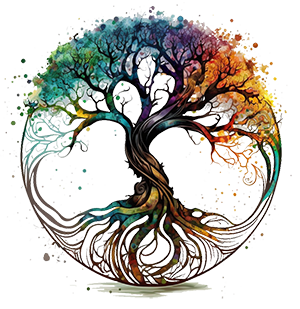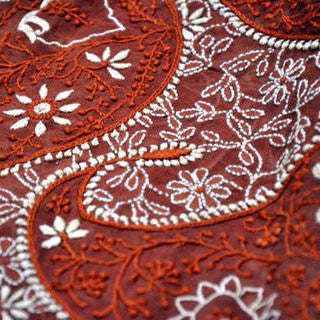Chikan is a traditional embroidery style from Lucknow, India. Literally translated, the word means embroidery. Believed to have been introduced by Nur Jehan, Mughal emperor Jahangir's wife, it is one of Lucknow's most famous textile decoration styles.
There are several theories about the origin of Chikankari. Chikankari - the process of chikan - was basically invented in Lucknow. The origin of Chikankari is initiated by the influence of intricate carving patterns of Mughal architecture during their period. The Chikan work in Lucknow is older than 200 years and later it is patronized by Nawabs. There are 5000 families involved in Chikankari embroidery in and around villages of Lucknow. The artisans belong to local Muslim community. Nearly 90% of Chikankari work is done by women professionally. Lucknow grew into an international market for its renowned Chikankari work. There are references to Indian Chikan work as early as 3rd century BC by Megasthenes, who mentioned the use of flowered muslins by Indians. The name Chikan has been derived from the Persian word Chakin or Chikeen meaning a cloth wrought with needlework




Chikankari Stitches :
The basic stitches are six in number and all except one are common to other forms of embroidery.
1) Tepchi is a long running or darning stitch worked with six strands on the right side of the fabric taken over four threads and picking up one. Thus, a line is formed. It is used principally as a basis for further stitchery and occasionally to form a simple shape.
2) Bakhiya, double back or shadow stitch in chikan work is done from the wrong side of the fabric and the design is rendered in the herringbone style. The shadow of the thread is seen through the cloth on the right side.
3) Hool is a fine detached eyelet stitch. Herein, a hole is punched in the fabric and the threads are teased apart. It is then held by small straight stitches all round and worked with one thread on the right side of the fabric. It can be worked with six threads and often forms the center of a flower.
4) Zanzeera is a small chain stitch worked with one thread on the right side of the fabric. Being extremely fine, it is used to finally outline the leaf or petal shapes after one or more outlines have already been worked.
5) Rahet is a stem stitch worked with six threads on the wrong side of the fabric. It forms a solid line of back stitch on the right side of the fabric and is rarely used in its simple form but is common in the double form of dohra bakhiya as an outlining stitch.
6) Banarsi stitch has no European equivalent and is a twisted stitch worked with six threads on the right side of the fabric. Working from the right across about five threads a small stitch is taken over about two threads vertically. The needle is reinserted halfway along and below the horizontal stitch formed and is taken out about two threads vertically on the right above the previous stitch.
7) Khatau is similar to Bakhia, but finer and is a form of applique. In Khatau, the design is prepared on calico material. That is placed over the surface of the final fabric and then paisley and floral patterns are stitched on to it.
8) Phanda and Murri are the forms of stitches used to embroider the centre of the flowers in ordinary chikan work motifs. They are typically French knots, with murri being rice-shaped and phanda millet-shaped.
9) Jali stitch is the one where the thread is never drawn through the fabric, ensuring that the back portion of the garment looks as impeccable as the front. The warp and weft threads are carefully drawn apart and minute buttonhole stitches are inserted into the cloth.
10) Turpai and Darzdari are also significant stitches in chikan work. Turpai should have an effect of a thin thread. Darzdari have several varieties, the popular ones are Kohidarz, Kamal darz, Shankarpara darz, Muchii and Singbhada darz.
11) The various other types of legendary chikankari stitches are: Pechani, Bijli, Ghaspatti, Makra, Kauri, Hathkadi, Banjkali, Sazi, Karan, Kapkapi, Madrazi, Bulbul-chasm, Taj Mahal, Janjeera, Kangan, Dhania- patti, Rozan, Meharki, Chanapatti, Baalda, Jora, Keel kangan, bulbul, sidhaul, ghas ki patti etc.
Drifting apart from the original pristine setting, the tone-on-tone embroidery is in vogue these days. The significant use of beads, sequin and mokaish (white flat silver strip embroidery) have gained wide acceptance.
References
http://www.dsource.in Documented by Dr. Bibhudutta Baral, Mr. J. Antony William and Ms. Anushree Kumar , NID R&D Campus, Bangalore
http://www.hand-embroidery.com/
For Embroidery enthusiasts here is a nice write up on how to create a design using various stitches written by Preethi


2 comments
i love hand embroidery where i can buy.
I am great fan of chikankari myself. I am mighty impressed with the enchanting way, the subject was approached, interweaving the pattern & methods.
Great beyond words